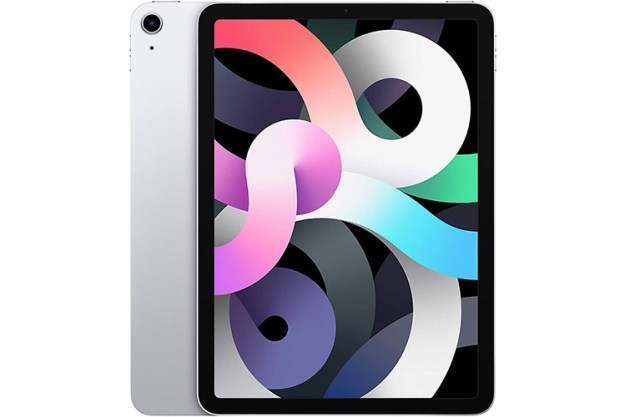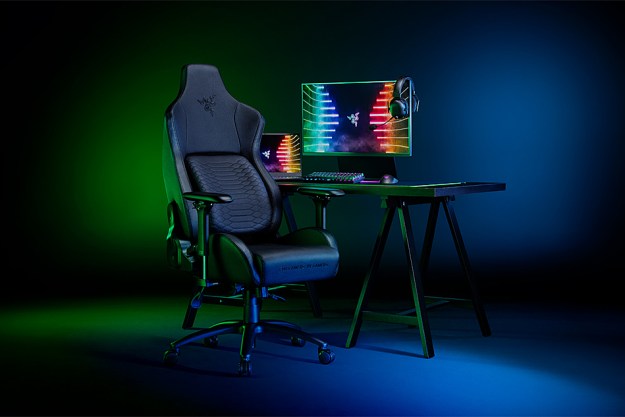When Corsair asked if I wanted to have a go at the new K100 RGB, I instantly knew I had to say yes. I owned the first K70 mechanical keyboard as a kid, and given that I haven’t used a Corsair plank in what feels like almost a decade, putting the new K100 on my desk had me feeling warm and fuzzy inside. And unlike many keyboards that pass through my office, this one actually stayed on my desk for the duration I had access to it, so spoiler alert: Yes, I like it.
In Corsair’s pitch, the company said the new K100 has “the most RGB we’ve ever put in a keyboard.” If that isn’t cause for concern, I don’t know what is. But Corsair has managed to build a keyboard fitting of this bold claim, without overdoing it on the RGB.

The K100 RGB dethrones the K95 RGB from its flagship position, bringing some much-appreciated updates that go beyond the lavish lighting. Per doctor’s orders, the wrist rest has been improved. There’s also a new iCue wheel, the volume wheel has been updated, and even the keycaps got some love. There’s also new AXON 4000Hz processing technology underneath, and with this keyboard, Corsair is introducing its OPX optical-mechanical switch.
Just how much keyboard do you want?
The Corsair K100 RGB is huge. While something like the Razer Huntsman Mini whispers “less is more,” the K100 RGB will instead sit on your desk, boldly proclaiming “more is never enough!”

With the wrist rest attached and the keyboard lifted upward, it measures 18.5 inches wide, 9.2 inches deep, and rises as much as 1.9 inches tall at its highest point. This is a serious tank.
The K100 RGB will sit on your desk, boldly proclaiming more is never enough!
Of course, Corsair isn’t ditching its hallmark design. The main chassis is made from one huge slab of brushed aluminum, which gives the keyboard a premium feel. Unlike the more budget-oriented keyboards in Corsair’s lineup, it’s clear that the K100 is built to a high standard.
Lots of attention is put into little details, ranging from the fine texture on the volume and iCue wheels, to the tiny “//K100” logo on the bottom left corner.

The wrist rest has also been updated, and while it looks nothing like it, it’s made from a squishy material that your hands lightly sink into. It’s not quite as soft as the wrist rest of Razer’s new flagship keyboard, but I see that as a good thing. I don’t fear that this one will wear out prematurely, and because it has a pattern on it, this wrist rest handles sweaty palms much better than Razer’s. It’s also magnetized, so it’ll stick to the keyboard instead of just loosely being placed near the keyboard.
On my first sample, with the K100’s kickstand up (lifting the back of the keyboard up), the front end of the wrist rest was pushed up by the keyboard. Any time I put my hands on it, it would thud on my desk.
My second sample didn’t have this issue, but swapping its wrist rest to the first sample only reduced the issue, and using the good keyboard with the first wrist rest didn’t help either.
It’s not a deal-breaker, and is easily fixed with slightly thicker rubber feet under the keyboard, but this shouldn’t happen on a flagship keyboard, so ask Corsair for a fix if you’re experiencing the same thing. Corsair offered to send us yet another unit to verify that the issue is not widespread — and indeed, this new sample sits stable on flat desks without any thudding from the wrist rest.

The RGB lighting doesn’t disappoint. Naturally, it’s all individually addressable, and I’m not even going to try to count it all (just look at the underglow produced by the RGB zones on the side of the keyboard).
How are the switches?
We opted for a sample with Corsair’s own OPX optical switches, and we’re glad we did. This is the first keyboard to come from the company with these new switches, and they look much like Cherry’s MX switches. However, they’re actuated through optics underneath instead of electrical contacts, and they’re surprisingly great to type on. These switches are linear, actuating at 1 mm down on the 3.2 mm travel distance, requiring 45 grams to press. They’re rated for a total of 150 million actuations.
I’ve never enjoyed a linear switch this much, especially when it comes to typing.
However, what I found most noteworthy about them is their stability and fluid travel. They felt very smooth and refined, and I’ve honestly never enjoyed a linear switch this much – especially for typing. On them are double-shot keycaps with a matte finish, which should keep looking good over the course of the keyboard’s lifetime.
What about that iCue wheel?
I’ve said this before and I’ll say it again. The RGB control software that Corsair makes is second to none, and this goes for all products in its portfolio. While it may appear dated in its looks, its functionality more than makes up for that, and it has some great RGB effects — or you can make your own or download community-made effects.

But the iCue wheel? I don’t get it. Neither clicking the button in the middle, nor using the rotating action, is distinct enough. By default, it’s set either to brightness control, track jogging, track selecting, or macro recording (you switch by pressing the middle button), and while you can customize it (artists may find it useful for zooming or adjusting brush sizes), I’m just not convinced it has a real purpose for most owners.
It seems like it’s there so the K100 RGB is different from the K95 RGB, but I’d like the keyboard more without it for a cleaner look. Everything about the keyboard is sleek, with sharp angles and clean lines — and then there’s that big obnoxious circle.
Almost the perfect keyboard

Corsair does a lot of things right with the K100 RGB. It comes with a great chassis, tons of RGB customization, and an oh-so-comfortable wrist rest (minus the problem with my first unit). I’m not convinced about the iCue wheel, and if I’m honest, I wish there was a wireless version. With Logitech and Razer now building wireless flagship keyboards, I feel like it’s Corsair’s turn to step up and cut the cord. too.
I just wish it was wireless.
Then there’s the matter of price. Wired flagships go for about $200 nowadays, with wireless variants at a $50 premium. The K100 RGB costs a mighty $230, which isn’t cheap, especially considering that for only $20 more, you can get both Logitech’s and Razer’s flagships in their wireless variants. However, Corsair’s keyboard feels like it’s built to a higher standard, and certainly deserving of a spot on our best keyboards page, preferably somewhere near the top
Update 5-10-2020, 9:40am PT: This article was updated to address an issue with the wristrest. A new unit sent by Corsair did not replicate the problem.
Editors' Recommendations
- Corsair relaunches popular gaming keyboard with optical switches
- Corsair K70 RGB TKL is an excellent gaming keyboard, if only it came out in 2016
- Have big hands? The Corsair Night Sword RGB is the gaming mouse for you




